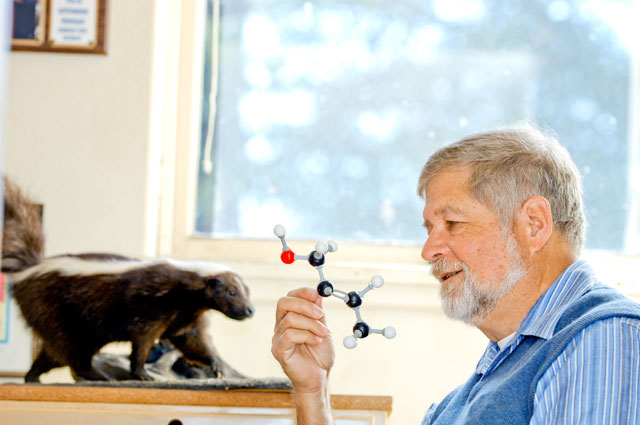DeShazer was a graduate student in 1985 when he became interested in the odor-causing chemical of the candy cap mushroom. Frequently used in cookies, cakes and ice cream, the mushroom is odorless when fresh but smells like butterscotch or maple syrup when dried.
So he asked Chemistry Professor William Wood, a specialist in chemical ecology. Wood didn’t know the answer, so he encouraged DeShazer to help him find an explanation. Their research finally ended last month when Wood identified the chemical as “quabalactone III,” using a relatively new technique called solid-phase micro extraction.

He published the findings in a recent issue of Biosystematics and Ecology. “It was a question that was bothering me for about 25 years,” Wood says.
Interestingly enough, the question didn’t pique Wood’s curiosity initially, DeShazer recalls: “It wasn’t on his radar.”
But as the years went on—and DeShazer’s question remained unanswered—Wood’s fascination grew. After DeShazer graduated, Wood assigned a succession of four students over several years to pick up where DeShazer’s research had left off. They and DeShazer are listed as co-authors on the paper.
Although each student reached the same dead end as DeShazer, their findings contributed to the final breakthrough, Wood says. That came earlier this year when Wood decided to try a new technique to identify the chemical called solid-phase micro extraction.
During previous attempts, students had dissolved the mushroom in a solvent before using a gas chromatograph-gas spectrometer, a machine that separates, weighs and fragments molecules to identify unknown compounds. But that technique sullied the sample with impurities.
With the new method, Wood was able to isolate the gas molecules responsible for the scent. He determined that “quabalactone III” likely forms from free amino acids after the mushroom dries.
The chemical is also found in the flowers of the Rosita de Cacao tree, native to South America. Aztecs once used the flowers as perfume and to flavor chocolate drinks.
The dry candy cap fragrance is so strong—and long lasting—that Wood still uses the sample he picked in the woods 25 years ago. Today, an eight-ounce package sells for about $150 online.
Wood says the paper was a group effort because each student’s research brought him closer to the answer. The other alumni authors are Jay Brandes, Brian Foy, Christopher Morgan and Thierry D. Mann.
DeShazer, now a high school biology teacher in Petaluma, Ca. and science advisor for a local mushroom club, says he was amazed to hear Wood had made headway.
“I was little surprised that he was actually still working on it,” says DeShazer. “But it was definitely satisfying.” He now uses the story as a teachable moment in class.
“High school kids are incredibly impatient so the fact that it carried on for a quarter of a century and finally yielded results was kind of a big deal,” DeShazer says.
Not long after the research was published, someone asked him to bake a cake for a school fundraiser.
“Of course I put the mushrooms in it,” DeShazer says. “It took the highest bid.”